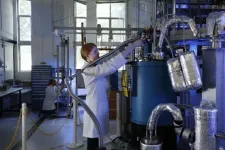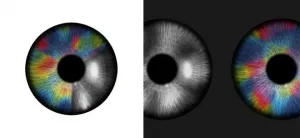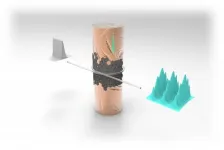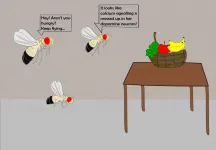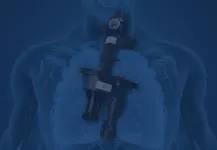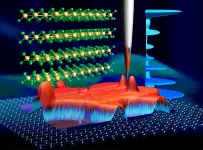(Press-News.org) Why is studying spin properties of one-dimensional quantum nanowires important?
Quantum nanowires-which have length but no width or height-provide a unique environment for the formation and detection of a quasiparticle known as a Majorana zero mode.
A new UNSW-led study overcomes previous difficulty detecting the Majorana zero mode, and produces a significant improvement in device reproducibility.
Potential applications for Majorana zero modes include fault-resistant topological quantum computers, and topological superconductivity.
MAJORANA FERMIONS IN 1D WIRES
A Majorana fermion is a composite particle that is its own antiparticle.
Antimatter explainer: Every fundamental particle has a corresponding antimatter particle, with the same mass but opposite electrical charge. For example, the antiparticle of an electron (charge -1) is a positron (charge +1)
Such unusual particle's interest academically and commercially comes from their potential use in a topological quantum computer, predicted to be immune to the decoherence that randomises the precious quantum information.
Majorana zero modes can be created in quantum wires made from special materials in which there is a strong coupling between their electrical and magnetic properties.
In particular, Majorana zero modes can be created in one-dimensional semiconductors (such as semiconductor nanowires) when coupled with a superconductor.
In a one-dimensional nanowire, whose dimensions perpendicular to length are small enough not to allow any movement of subatomic particles, quantum effects predominate.
NEW METHOD FOR DETECTING NECESSARY SPIN-ORBIT GAP
Majorana fermions, which are their own antiparticle, have been theorised since 1937, but have only been experimentally observed in the last decade. The Majorana fermion's 'immunity' to decoherence provides potential use for fault-tolerant quantum computing.
One-dimensional semiconductor systems with strong spin-orbit interaction are attracting great attention due to potential applications in topological quantum computing.
The magnetic 'spin' of an electron is like a little bar magnet, whose orientation can be set with an applied magnetic field.
In materials with a 'spin-orbit interaction' the spin of an electron is determined by the direction of motion, even at zero magnetic field. This allows for all electrical manipulation of magnetic quantum properties.
Applying a magnetic field to such a system can open an energy gap such that forward -moving electrons all have the same spin polarisation, and backward-moving electrons have the opposite polarisation. This 'spin-gap' is a pre-requisite for the formation of Majorana zero modes.
Despite intense experimental work, it has proven extremely difficult to unambiguously detect this spin-gap in semiconductor nanowires, since the spin-gap's characteristic signature (a dip in its conductance plateau when a magnetic field is applied) is very hard to distinguish from unavoidable the background disorder in nanowires.
The new study finds a new, unambiguous signature for the spin-orbit gap that is impervious to the disorder effects plaguing previous studies.
"This signature will become the de-facto standard for detecting spin-gaps in the future," says lead author Dr Karina Hudson.
REPRODUCIBILITY
The use of Majorana zero modes in a scalable quantum computer faces an additional challenge due to the random disorder and imperfections in the self-assembled nanowires that host the MZM.
It has previously been almost impossible to fabricate reproducible devices, with only about 10% of devices functioning within desired parameters.
The latest UNSW results show a significant improvement, with reproducible results across six devices based on three different starting wafers.
"This work opens a new route to making completely reproducible devices," says corresponding author Prof Alex Hamilton UNSW).
INFORMATION:
THE STUDY
New signatures of the spin gap in quantum point contacts was published in Nature Communications in January 2021 (DOI 10.1038/s41467-020-19895-3).
As well as support by the Australian Research Council, funding was received from Germany's Deutsche Forschungsgemeinschaft the UK's Engineering and Physical Sciences Research Council and the Sydney Quantum Academy.
Semiconductor crystals were grown at the University of Cambridge and the Ruhr-Universitat Bochum. Devices were fabricated and examined at UNSW, Sydney. Theoretical studies were performed at the University of Massachusetts Boston and Ludwig-Maximilians Universität, München
A KAIST team's mathematical modelling shows that the topographic tiling of cortical maps originates from bottom-up projections from the periphery.
Researchers have explained how the regularly structured topographic maps in the visual cortex of the brain could arise spontaneously to efficiently process visual information. This research provides a new framework for understanding functional architectures in the visual cortex during early developmental stages.
A KAIST research team led by Professor Se-Bum Paik from the Department of Bio and Brain Engineering has demonstrated that the orthogonal organization of retinal mosaics in the periphery is mirrored onto the primary visual cortex and initiates ...
Overview:
Third-year doctoral student Toshiaki Takahashi, associate professor Kazuhiro Takahashi, and their research team from the Department of Electrical and Electronic Information Engineering at Toyohashi University of Technology developed a testing chip using semiconductor micro-machining that can detect volatile gasses in exhaled breath in ppm concentrations at room temperature. A polymer that expands and contracts when gas is absorbed is formed on a flexibly deformable nanosheet, and the amount of deformation that occurs when a target gas is absorbed is measured, allowing gas to be detected at high sensitivity. ...
New research shows that patterns inspired by lobster shells can make 3D printed concrete stronger, to support more complex and creative architectural structures.
Digital manufacturing technologies like 3D concrete printing (3DCP) have immense potential to save time, effort and material in construction.
They also promise to push the boundaries of architectural innovation, yet technical challenges remain in making 3D printed concrete strong enough for use in more free-form structures.
WATCH AND EMBED THE VIDEO: https://youtu.be/mpPAPlst42o
In a new experimental study, researchers at RMIT University ...
Pulsed lasers repeatedly emit light for a short period of time as if blinking. They have the advantage of focusing more energy than a continuous wave laser, whose intensity is kept unchanged over time. If digital signals are loaded in a pulsed laser, each pulse can encode one bit of data. In this respect, the higher the repetition rate, the more the amount of data that can be transmitted. However, conventional optical-fiber-based pulsed lasers have typically had a limitation in increasing the number of pulses per second above the MHz level.
The Korea Institute of Science and Technology (KIST) announced that the research ...
Synthetic cannabidiol, better known as CBD, has been shown for the first time to kill the bacteria responsible for gonorrhoea, meningitis and legionnaires disease.
The research collaboration between The University of Queensland and Botanix Pharmaceuticals Limited could lead to the first new class of antibiotics for resistant bacteria in 60 years.
The UQ Institute for Molecular Bioscience's Associate Professor Mark Blaskovich said CBD - the main nonpsychoactive component of cannabis - can penetrate and kill a wide range of bacteria including Neisseria gonorrhoeae, which causes ...
'A journey of a thousand miles begins with a single step' is a popular adage that talks about the initial thrust required to embark on a task. However, once begun, how do we persevere on the job and not let it fall apart like a New Year resolution? How do we stay motivated?
Well, these are not just philosophical deliberations, but compelling science projects for neuroscience aficionados. Scientists have in fact been on the lookout for the neuronal and molecular players which are at the root of governing motivation.
Here is a research story from the generous fruit fly that identifies the machinery behind the fly's relentless flying pursuits.
Prof. Gaiti Hasan's group, in a recent study, has discovered that the ability of flies to sustain ...
Your food intake patterns are partly under genetic control, according to the latest research from researchers at King's College London, published today in the journal Twin Research and Human Genetics.
Researchers can study the quality of an individual's typical diet by using a type of analysis called 'dietary indices'. Researchers use dietary indices to understand what foods someone eats and the nutrients provided, compared with recommended guidelines.
The team analysed food questionnaire responses from 2,590 twins, using nine commonly used dietary indices. The researchers studied the degree of similarity among identical twins - who share 100% of their genes - compared with non-identical twins, who share 50% of their genes.
The team found that identical twin pairs ...
The design, testing, and validation of the Illinois RapidVent emergency ventilator has been published in the journal Plos One. The article, "Emergency Ventilator for COVID-19," by University of Illinois Urbana researchers, is the first of its kind to report such details about an emergency ventilator that was designed, prototyped, and tested at the start of the COVID-19 pandemic in 2020.
"This article reports the development and testing of the RapidVent emergency ventilator," said William King, professor at The Grainger College of Engineering and Carle Illinois College of Medicine, and leader of the RapidVent ...
Previously controversial values of the energy gap of a van der Waals material -- chromium tribromide -- were reported based on various optical measurements. A University of Wyoming faculty member and his research team used scanning tunneling microscopy and spectroscopy measurements that clearly reveal a much smaller energy gap value and resolved the controversy.
"Our results settled a long controversy on one important material property -- the energy gap of the material," says TeYu Chien, an associate professor in the UW Department of Physics and Astronomy. "Our scanning tunneling microscopy and spectroscopy measurements clearly revealed that the energy gap is around 0.3 electron volt (eV), which is much smaller than those measured by optical ...
Nearly every galaxy hosts a monster at its center -- a supermassive black hole millions to billions times the size of the Sun. While there's still much to learn about these objects, many scientists believe they are crucial to the formation and structure of galaxies. What's more, some of these black holes are particularly active, whipping up stars, dust and gas into glowing accretion disks emitting powerful radiation into the cosmos as they consume matter around them. These quasars are some of the most distant objects that astronomers can see, and there is now a new record for the farthest one ever observed.
A team of scientists, led by former UC Santa Barbara ...
